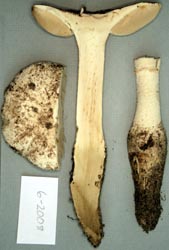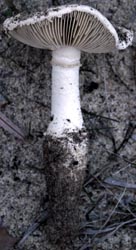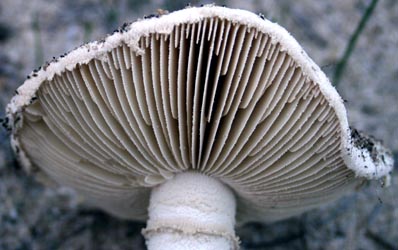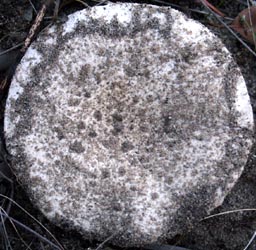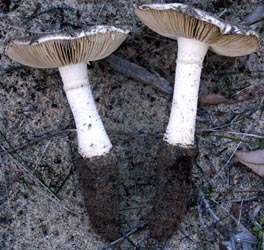|
[ Section Lepidella page. ]
[ Amanita Studies home. ]
[ Keys & Checklist/Picturebooks ] "Ocher Earth Lepidella"
Technical description (t.b.d.) BRIEF DESCRIPTION: This description is based on Bas' (1969) original description. The cap of Amanita ochroterrea is 100 - 110 mm wide, convex to plane or plano-concave with age, dingy buff, darker with age, with a nonsulcate, appendiculate margin. The cap is covered with more or less felted-subfloccose, indistinctly delimited, patch- or crust-like remnants of volva especially at the center. The gills are crowded, free or just reaching the top of the stem, moderately broad, and dingy buff to dark buff. The short gills are truncate. The stem is 160 - 190 x 20 - 30 mm, dingy buff, with a few more or less concentric rows of recurving, small scales. The spores measure (10-) 11 - 13 (-13.5) x 5 - 6.5 Ám and are amyloid and cylindrical to elongate. Clamps are present at bases of basidia. Amanita ochroterrea is known only from the state of Western Australia, Australia. Bas placed this species in his stirps Grossa. It was originally interpreted by Gentilli as a form of A. preissii (Fr.) Sacc.; however, because of the difference in volval structure, the presence of clamps, and a less gelatinized structure of the cap's skin, Bas argued instead that A. ochroterrea be placed in his stirps Grossa (see the discusssion of A. grossa (Berk.) Sacc.). See also, an extended discussion under Amanita austroviridis O. K . Mill. Drawing: Dr. C. Bas (1969) (reproduced by courtesy of Persoonia, Leiden,
the Netherlands)
[ Section Lepidella page. ]
[ Amanita Studies home. ]
[ Keys & Checklist/Picturebooks ] Last changed 6 October 2009. |

